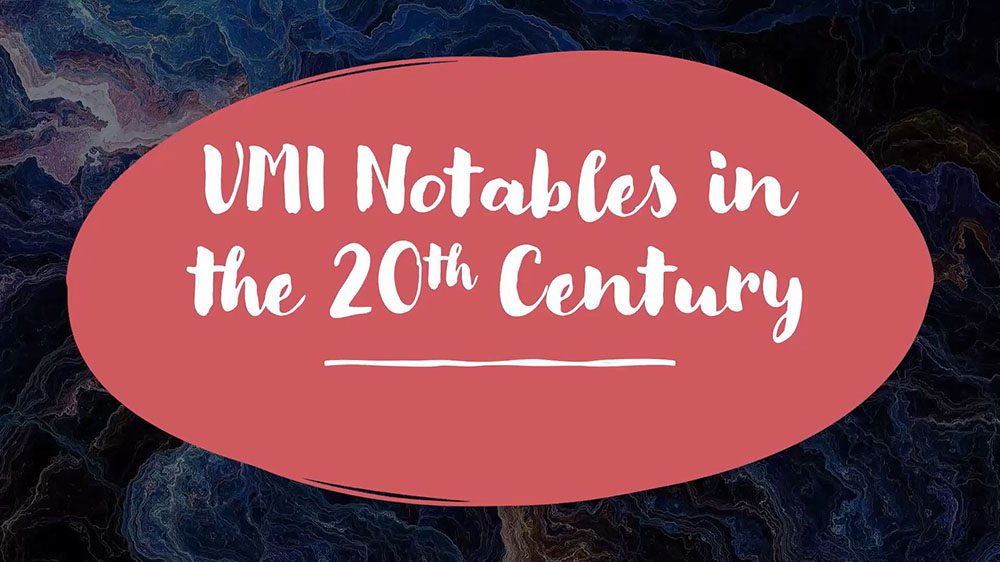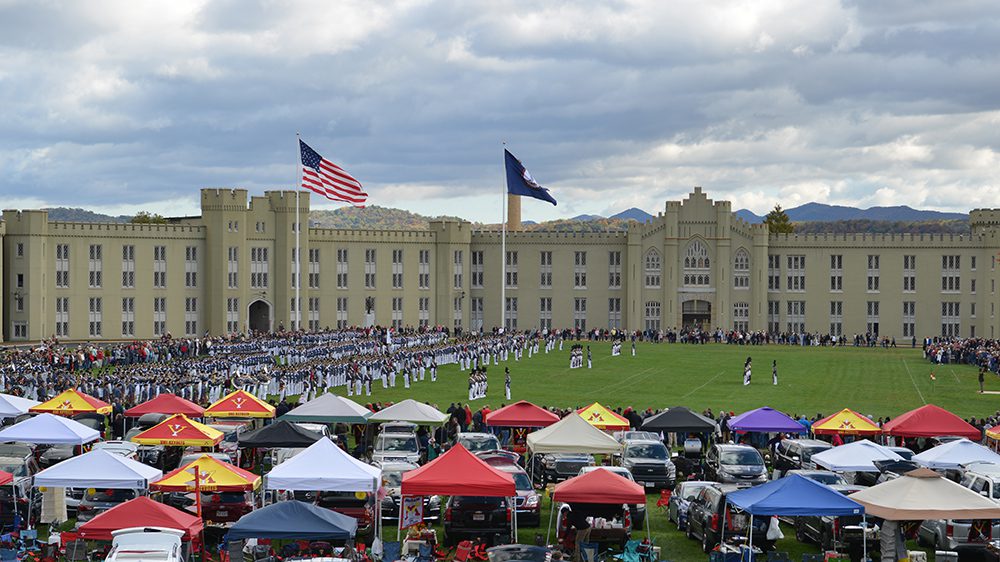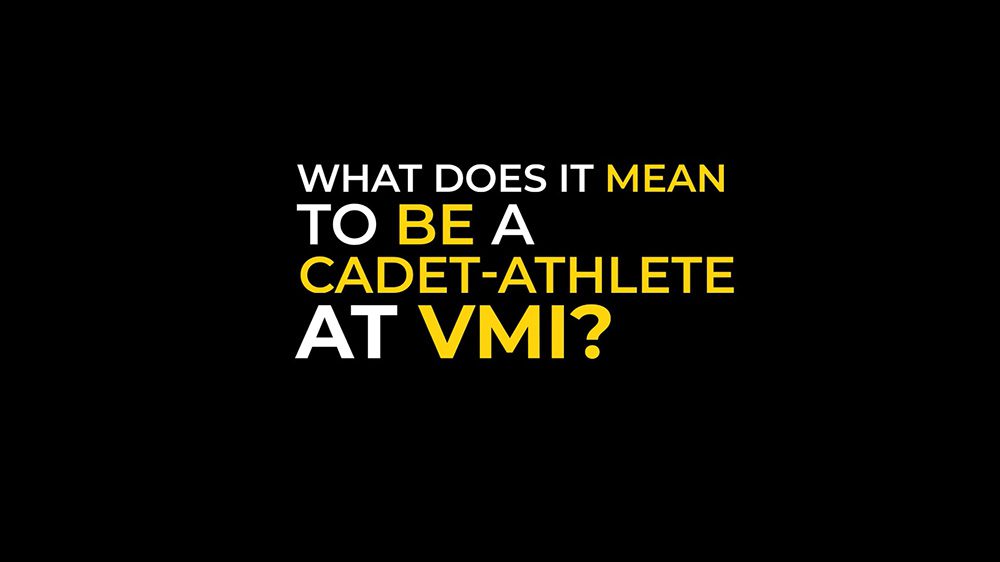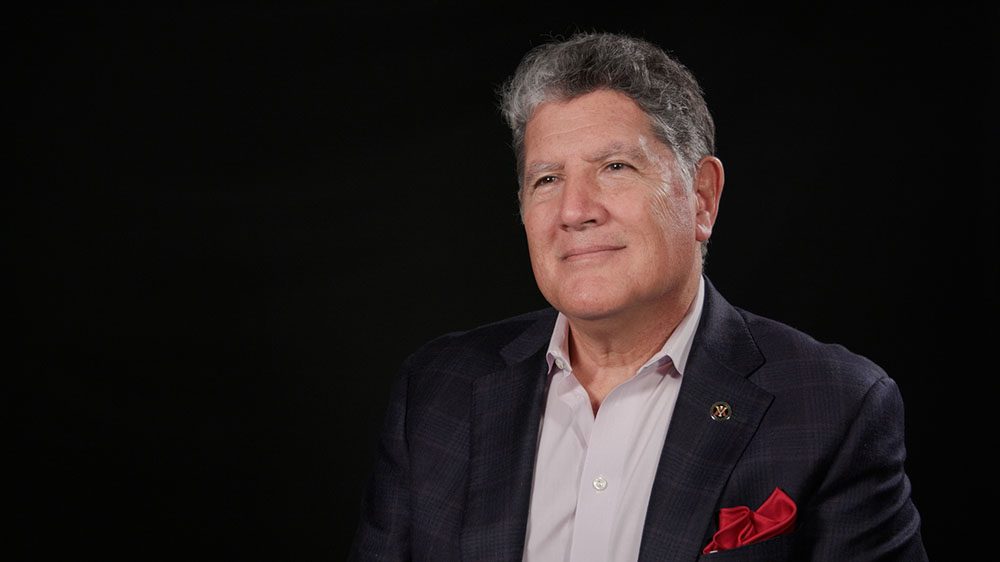There are hundreds of VMI notables in the 20th century, and here I have just focused on a few, starting with U.S. Army Gen. George C. Marshall, Class of 1901. Marshall was the Army chief of staff who was credited as “the organizer of victory” for U.S. forces during World War II. Marshall was known for not having favorites, but he surrounded himself with VMI men. For the majority of the war, Frank McCarthy, Class of 1933, sat outside his office and maintained Marshall’s correspondence with dozens of VMI men.
McCarthy had a brilliant career at VMI, earning academic stars for all his eligible years. He was editor of the Bomb yearbook for 1933. His 1st Class year, he wrote and starred in a musical play that was a hit. He held rank, culminating as a cadet captain, and he earned the Cincinnati Medal for efficiency of service and excellence of character.
Other than Mrs. Marshall, no one was closer to the general than McCarthy, who was privileged to be called “Frank” by Marshall. McCarthy was a media sensation by the end of the war, often appearing in print. He was asked if he could be nominated to be superintendent of VMI by the Alumni Association. He was 33 years old. Instead, with Marshall’s help, McCarthy became the assistant secretary of state, the youngest in U.S. history. After a few weeks in the office, someone, likely in J. Edgar Hoover’s office, showed McCarthy a dossier that caused him to resign his post and leave Washington forever.
McCarthy’s secret was out to a very few. He was gay. That didn’t stop his promotion to brigadier general in the Army Reserve. He continued to visit and correspond with the Marshalls as a career in Hollywood brought him many successes as a studio executive and producer. After 20 years of effort, the movie Patton earned him and its star an Oscar.
Those who knew McCarthy saw a “manly man” with a soft Virginia accent who made you the center of his attention when you spoke with him. McCarthy was extremely loyal to VMI, always helping with fundraising and contributing himself. He attended a VMI reunion shortly before his death in 1986.
Lewis Burwell “Chesty” Puller, Class of 1921, attended VMI for one year. He resigned, hoping to make it into World War I. He regretted all his life not returning to VMI and was a very loyal alumnus. He credited VMI with making a man out of him. He served in Company B while a cadet.
As a young captain, he was sent to Fort Benning (now Fort Moore) by the Marine Corps, where he met Marshall (then a lieutenant colonel), and Marshall took an interest in Puller. Now known as “Chesty,” Puller shared his combat stories fighting in Haiti and Nicaragua with his class. He had already earned a Navy Cross, our nation’s second-highest award for valor.
Puller earned another Navy Cross, his third, at Guadalcanal in World War II. Marshall asked the Marine Corps to borrow him—to share his experience fighting the Japanese with Army soldiers stationed at a number of posts across America.
Puller was known for his outspokenness and his quick wit. After a demonstration of the new flamethrower, he asked, “Where do you put the bayonet?”
By his retirement, at which time he had reached the rank of lieutenant general, Puller had earned his nation’s second-highest medal six times, five Navy Crosses, and an Army Distinguished Service Cross. These were all for valor in combat. He was then and is now the most decorated Marine in U.S. history. Puller spent an amazing 11 years in combat during his 37-year career. He had an instinctive sense of when danger was imminent. He visited VMI a number of times in his retirement.
Albert “Bert” Earnest, Class of 1938, was 25 years old with no combat experience when he took off from Midway Island flying a new Avenger with 14 other aircraft in June 1942. Their mission was to find and bomb the Japanese fleet. The Japanese had four carriers plus a huge group of supporting ships. They planned to take Midway and finish off the U.S. carrier fleet that they missed during the Pearl Harbor attack.
Earnest’s group of aircraft found the Japanese fleet, and they were mobbed by attacking Japanese Zero fighter aircraft. Earnest’s two-man crew was either killed or wounded. Earnest was shot in the neck, and blood spurted on his windshield from the wound. He pressed his finger on his neck to stop the blood flow while he maneuvered his plane with his other hand. He successfully dropped his bombs, but his controls were all shot up, and his radio was inoperable. Somehow, he pointed his aircraft back to Midway, following the sun until he saw smoke coming from the island. He landed on one wheel and crawled out of his wrecked aircraft. He gave his superiors directions to the Japanese fleet. His aircraft was the only one to return. The Americans won a decisive victory, sinking all four Japanese carriers. This battle was the turning point in the war for the Americans and stopped Japanese expansion in the Pacific.
Earnest received two Navy Crosses in one day from U.S. Navy Adm. Chester Nimitz for his efforts. The first was for dropping his bombs, and the second was for returning home with a location of the fleet. Later, Earnest received a third Navy Cross for his valor during the air battle over Guadalcanal. This likely made him the most decorated VMI man of the war.
Earnest made captain and learned to fly jets before he retired to Virginia Beach. He gave his awards to the VMI Museum and was well-known in alumni circles.
Leonard T. “Gee” Gerow, Class of 1911, was a World War I veteran, a brigadier general, and head of war plans in the Pentagon when World War II began. He often saw Marshall with his deputy, Dwight Eisenhower.
Their roles would soon reverse, and they retained a lifelong friendship even as Eisenhower became the theater commander and Gerow became V Corps commander in Europe. He led V Corps, landing at Omaha Beach on D-Day, and through much of the war until he was given an Army command. Eisenhower considered Gerow one of his top commanders. After Gerow retired following nearly 40 years of service, he was promoted to four-star general by an act of Congress during Eisenhower’s administration.
Gerow’s D-Day map resides in the Marshall Library. Gerow was another loyal VMI alum.
Lemuel C. “Lem” Shepherd Jr., Class of 1917, graduated a few months early from VMI so he and his classmates could go to war. The following year, Shepherd earned a Navy Cross and Army Distinguished Service Cross for leading his company through German lines at Belleau Wood after being wounded twice. Later, he was wounded a third time during the Meuse-Argonne Offensive. After the war, he was aide-de-camp to Maj. Gen. John A. Lejeune, commandant of the Marine Corps. Lejeune later served as VMI’s fifth superintendent.
During World War II, Shepherd was promoted to brigadier general on Guadalcanal and later commanded the 6th Marine Division on Okinawa through the fiercest fighting of the Pacific War. As commander, Fleet Marine Force, Pacific, he advised and observed the landings at Inchon during the Korean War with Gen. Douglas MacArthur. On Jan. 1, 1952, Shepherd became the first VMI alumnus to become commandant of the Marine Corps.
Shepherd was always a loyal VMI man.
Glover S. Johns Jr., Class of 1931, joined the 29th Division and landed with that division on D-Day, June 6, 1944. Within a week of landing, Johns took command of an infantry battalion and is credited with taking the key town of St. Lo, France, opening the way for the breakout and race across France by Gen. George S. Patton, Class of 1907.
Maj. Johns was promoted to lieutenant colonel and commanded his battalion through the entire war, earning three Silver Stars for valor in combat. He wrote a great book about his combat experiences called Clay Pigeons of St. Lo.
After World War II, Glover commanded an infantry regiment during the Korean War and then came to VMI as commandant. Everyone I interviewed said how impressive he was as commandant. Retired U.S. Army Lt. Gen. Josiah Bunting ’63, the Institute’s 13th superintendent, recalled him as “every inch a soldier.”
In 1961, Johns was assigned to command a battle group in Europe. President John F. Kennedy picked him personally to move his 1,500 men through East Germany to force his way into a blockaded Berlin. This was just as the East Germans were building the Berlin Wall. When Johns arrived at an entrance to Berlin, he spoke in fluent German to the guard and ordered that the gate be opened. The guard replied in German and said, “What if I don’t?” Johns pulled out his .45 caliber pistol and replied, “Then, you will be the first casualty of World War III.” The gate was opened.
Johns loved VMI, and after military service, he retired to his home in Texas, where he passed away in 1976.
Edward R. “Ned” Schowalter Jr. ’51 was just over a year from his VMI graduation. He was a company commander during the Korean War, and his company was to attack a House Mountain-like hilltop packed with Chinese soldiers. Schowalter moved forward with a .45 pistol and a grenade and was soon shot in the head and knocked unconscious. The bullet was lodged just above his ear. He awoke quickly and continued the attack, refusing medical aid. A grenade landed nearby, wounding him a second time. As he ascended the hilltop, a Chinese soldier shattered his right arm with a burp gun. Schowalter was down again and presumed dead. He was covered with dead Chinese. Still, he crawled out from under the pile of dead and secured the hilltop. Schowalter received the Medal of Honor from President Dwight D. Eisenhower, becoming VMI’s most recent alumnus to receive that award.
Schowalter hated the attention that came with the medal and refused interviews. He seldom returned to VMI and never for reunions— again, because the medal would always be a topic of discussion. He did return for a parade, which also included Gen. William H. Milton, Class of 1920, the Institute’s eighth superintendent, and Maj. Gen. Charles E. Kilbourne Jr., Class of 1894, a fellow Medal of Honor winner and the Institute’s sixth superintendent. Schowalter and Kilbourne won their medals 53 years apart.
During the Vietnam War, Schowalter was an adviser to a Vietnamese armored cavalry regiment. Their orders were to retake the town of My Tho southwest of Saigon. This was during the fierce 1968 Tet Offensive. The Vietnamese unit refused to move, so Schowalter headed down a main thoroughfare by himself toward the enemy, firing his Thompson submachine gun. This incredible act shamed the Vietnamese into following him and retaking the town. Schowalter was severely wounded and nearly died on the operating table. He received a Silver Star for valor. His son was told by a senior officer that his dad was nominated for a second Medal of Honor, which was denied because he had one.
Schowalter retired as an Army colonel and spent his remaining days devoted to his wife and five children in Auburn, Alabama. He remained close to a select few brother rats.
Thomas H. Kirk Jr. ’50B grew up in Portsmouth, Virginia, and he wanted to be a fighter pilot. He flew 70 missions in the Korean War and eventually learned to fly 22 types of aircraft. With the coming of the Vietnam War, Kirk took a two-week leave from a stateside assignment to fly 25 combat missions in Vietnam. Soon after, he was given a squadron command in Takhli, Thailand. During his 67th mission flying over North Vietnam, Tom led the largest aerial attack on Hanoi during the Vietnam War. As the lead aircraft aiming at a Hanoi bridge, he announced “roll-in.” Hanoi was the most heavily defended city in the world, and Kirk’s aircraft was riddled with flak. South of Hanoi, he ejected from the aircraft and became a prisoner of war for the next five-plus years.
Kirk was severely tortured and turned over to an expert torturer. Under his direction, Kirk was tied up and brutally tortured for three days. The third day, in intense pain, he broke down and confessed, but he had no idea what he said to his captors.
Kirk spent two years in solitary confinement by himself. When he was finally released from captivity in 1973, he returned to VMI and spoke to the Corps of Cadets, which included me. He joked that VMI had prepared him well for a POW camp. Later, he became a very successful businessman and entrepreneur, opening a financial planning business in Europe, a charter boat business, and a multitude of takeout pizza stores in Spain. He also built condos in Vail, Colorado. Kirk was a ski instructor in Vail. Throughout his life, starting from his youth, he played the saxophone in bands.
Today, well into his 90s, Kirk lives in Arizona. As of this writing, Kirk is VMI’s most decorated living graduate and the most decorated VMI graduate of the Vietnam War. His awards include the Air Force Cross (second highest medal for valor), four Silver Stars, two Distinguished Flying Crosses, two Legions of Merit, two Bronze Stars (one for valor), seven Air Medals, and a Purple Heart.
Thomas H. Tait ’55 was a 6’6” walk-on basketball player like his friend Buz Snyder ’57. There were no basketball scholarships back then, so everyone was a walk-on. Tait liked to wear white socks around post— the same ones he wore on court because they felt good. After repeated warnings, Tait was awarded a 10-6-30 (10 demerits, six weeks confinement, and 30 penalty tours) from the commandant for his repeated wearing of white socks. Tait was a private for his entire cadetship.
Later, Tait started an Army career, which included multiple tours in Germany, a Korean tour, and another in Vietnam, where he was wounded severely. He looked like a “pin cushion,” his nurse said. He served in the area of the infamous “Cu Chi Tunnels,” where the enemy had constructed 155 miles of underground bunkers. The enemy could pop out of holes anytime or anywhere.
Tait knew the German border like few others, having walked the heavily defended Cold War border often. During his third tour in Germany, the V Corps Commander, Lt. Gen. Paul S. Williams Jr. ’51, promoted Tait to brigadier general.
Tait later commanded Fort Knox, Kentucky. Many, including President George H. W. Bush, remember Tait carrying his “Big Stick,” the German fencepost Tait always carried with him, including during Hurricane Hugo. Tait was known as “CINC Hugo,” or Commander in Chief Hugo, for his tight control during this recovery operation. At one point, the governor of South Carolina called President Bush, asking who was in charge–him or Tait. Tait won out. Tait was loud and unapologetic but beloved by those who served with him. He retired to Lexington, where he died in 2020.
William H. “Bill” Dabney ’61 actually graduated with the Class of 1960 and, after graduation, had the distinction of being the son-in-law of the famed Puller. Dabney married Virginia Puller, Puller’s eldest daughter. Puller rubbed off on Dabney: He wanted the toughest assignments and was given just that in Vietnam.
During the Vietnam War, Dabney led two companies of Marines on Hill 881S, surrounded by a North Vietnamese battalion. He was located on the westernmost exposed position during the siege of Khe Sanh in 1968. Dabney defended a hilltop, which he described as similar to House Mountain. It had a circular trench system, and if you lifted your head up, a sniper would likely kill you. Dabney lost 42 men on that hill and many more wounded during a 77-day siege.
Seven helicopters were shot down trying to resupply him, and every time one landed, Dabney rushed out under fire to help load the wounded and receive rations and ammunition. Life on that hill was pure hell. Those who survived gave credit to Dabney for his outstanding leadership.
Dabney was nominated for the Medal of Honor and instead received a Navy Cross and Silver Star for his efforts. Later, he commanded a battalion and regiment before becoming the first Marine commandant of the Corps of Cadets in 1990–91. Dabney retired as a colonel and spent his remaining days in the Lexington area. He passed away in 2012.
Jim Berger ’61, known at one time as “Rat Berger,” graduated from VMI with a degree in civil engineering. He became a civil engineer in the Air Force, but he wanted to fly, and soon after earning his flight wings in a F4 Phantom fighter, Berger was assigned to Da Nang Air Base in Vietnam.
On his 30th mission flying as a backseater or GIB (Guy in Back), Berger’s plane was shot down by a SAM missile, which looked like a telephone pole coming at you, said one pilot. He was taken to the infamous Hanoi Hilton and was severely tortured.
Berger survived over six years as a POW. He returned home with a plan for his life, which involved his wife and two boys, then aged 10 and 8. Jim set up a barbershop in his backyard and gave the boys “cueball” haircuts. Life was easy with Mom, but Dad was home, and he kept the family busy together refinishing furniture, repairing cars, and once renovating a home for a Vietnamese friend. Berger’s sons remembered their father as tough but loving. Berger didn’t take vacations and ran the Lexington Building Supply very successfully for many years. He died in Lexington in 2015.
Finally, we remember Charles A. Ransom ’01. Ransom came to VMI from Midlothian, Virginia, where he was a star athlete and voted by his high school class as “Most Likely to Succeed.” At VMI, he focused on academics and was remembered as the shortest man in the Corps, standing somewhere around 5’4.” He took a lot of ribbing but met every challenge with a smile.
Ransom’s class was the first to have women, and he was elected class vice president. He promised to fight for his class and fight he did through four combat tours in Iraq and Afghanistan. In April 2011, Charles was at Kabul Airport for training when a crazed Afghan colonel entered the conference room where Ransom was and killed nine Americans before he was killed. This was the largest “Green on Blue” attack of the Afghan war.
Ransom was remembered by the Class of 2001 with a plaque in VMI’s Memorial Gardens. There are also more than a half-dozen memorials to Ransom around Virginia. He is remembered by those who knew him as a strong Christian who was very fit and always gave to others.
This has been a composite of VMI greats from the ones I have worked on. There are many more to add, and the 21st century is already looking to take us far in maintaining our military tradition of exemplary dedicated service. Best wishes and Rah Virginia Mil!
-
Jim Dittrich '76 VMI Alumni Association Historian




